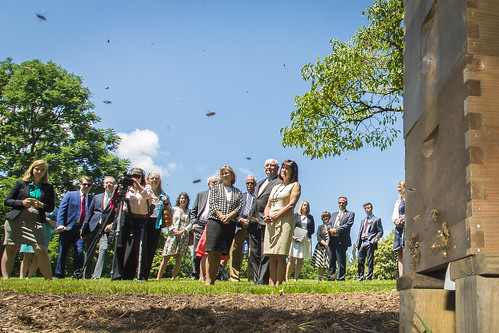
Pollinators are a vital part of agricultural production. In the United States, more than one-third of all crop production – 90 crops ranging from nuts to berries to flowering vegetables - requires insect pollination. Managed honey bee colonies are our primary pollinators, adding at least $15 billion a year by increasing yields and helping to ensure superior-quality harvests.
However, our beekeepers have been steadily losing colonies. The number of honey bee hives in this country has decreased from 6 million in the 1940s to about 2.5 million today.
Secretary of Agriculture Sonny Perdue declared June 19-25 as “National Pollinator Week” to help call attention to these losses, which are caused primarily by biological and environmental stressors. Confronting this diverse mix of challenges requires a mix of solutions, and the odds are that we won’t find one magic fix to help our honey bees.
On June 6, Secretary Perdue joined Karen Pence, wife of Vice President Mike Pence, to announce the installation of a honey bee hive on the grounds of the Vice President’s residence in Washington (watch video). They encouraged Americans to also consider setting up hives where possible, or at least to plant bee-friendly flowers and flowering herbs in their gardens and yards.
While these are helpful steps that people can take in their own communities, there is also a need for research to better understand this problem and how we can best address it. USDA was one of the co-leaders of a task force that developed a national strategy that laid out a research and management roadmap that we are busily implementing.
Our Agricultural Research Service is conducting research to improve the nutritional health of bees, to control the Varroa mite and other pests and pathogens, and to understand the effects of pesticides on colonies. We are setting up long-term studies to determine causes and evaluate treatments for Colony Collapse Disorder and other kinds of bee mortality, and we are establishing a bee gene bank to help breed traits such as resistance to pests or diseases and pollination efficiency.
Our National Institute for Food and Agriculture is funding important research at our land-grant universities in this area. For example, University of Nevada researchers have are experimenting with a virus that attacks a bacterial disease that affects honey bees. Meanwhile, Michigan State University scientists are developing sustainable pollination strategies such as enhancing the effect of bee-friendly wildflowers.
Our National Agricultural Statistics Service, working with the Animal and Plant Health Inspection Service have begun taking a nationwide survey of bee health that sets baseline values for pest and disease prevalence. The U.S. Forest Service and the Farm Service Agency has been creating and restoring hundreds of thousands of acres of pollinator habitat, while the Natural Resources Conservation Service has provided financial assistance to landowners to protect or restore 30,000 acres of private lands.
Honey bees may be some of the hardest workers you’ll ever see, but they need our help. At USDA, we are making sure that they get it.


